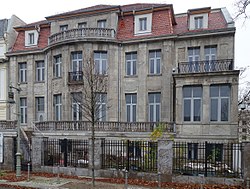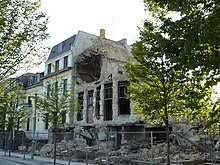Greek Embassy in Berlin
|
|||
|---|---|---|---|
| State level | bilateral | ||
| Position of the authority | Embassy | ||
| Supervisory authority (s) | Foreign Ministry | ||
| Headquarters |
|
||
| ambassador |
Theodoros Daskarolis (since 2015) |
||
| Website | Greek embassy | ||
The Greek Embassy in Berlin (officially: Embassy of the Hellenic Republic in Germany ) is the diplomatic representation of Greece in Germany. It is located on an interim basis - until the new embassy building is completed at the historical location on Hiroshimastraße .
organization structure
The embassy maintains the following embassy departments: the political department, the education, consular and military departments, the economic and commercial department and the press and information office.
In addition, Greece has consulates general in ( Düsseldorf , Frankfurt am Main , Hamburg , Munich and Stuttgart ).
Theodoros Daskarolis has been the Greek ambassador since 2015 .
history
As early as 1834, the newly founded Greek state set up a diplomatic representation in the capital of the Kingdom of Prussia , which did not operate an official office in the first few decades. In the Berlin address books from the end of the 19th century, however, envoys and an embassy secretary are always named with their respective residential addresses. The embassy in Germany persisted despite all historical changes. After the division of Germany, the Greek Republic maintained an embassy in Bonn (see entry in the embassy list ) and since 1973 in the GDR with its seat in Berlin ( Otto-Grotewohl-Strasse 3a ; since 1993: Wilhelmstrasse 66).
Embassy building in Berlin
| Greek Embassy in Berlin | |
|---|---|
 Building of the Greek Embassy on Hildebrandstrasse, November 2015 |
|
| Data | |
| place | Berlin center |
| Construction year | 1912, redesigned in 1920; 2011–2012 rebuilding (unfinished) |
| Coordinates | 52 ° 30 '51.3 " N , 13 ° 23' 37.9" E |
The later embassy building was built in 1912 according to plans by the architect Robert Leibnitz as a residential building for the factory owner Sigmund Bergmann and was part of a villa colony. It is located on a long plot of land in the square Hildebrandstrasse 4 / Reichpietschufer / Hiroshimastrasse 11-13 / Tiergartenstrasse in the immediate vicinity of the Italian Embassy and the Great Zoo .
The building, designed in the style of neoclassicism , had two decorated facades facing the streets to the east and west of the building. A generous floor plan enabled a clear division of use - common rooms were created on one side of the street, on what was then Hohenzollernstraße (later Graf-Spee-Straße, today Hiroshimastraße) were the living and sleeping rooms of the manufacturer family, the building wings connected by a gallery-like dining room. When further embassies settled in the capital after the end of the Empire , the Greek state rented the property including the villa and moved its diplomatic representation here from 1920. In 1940, with the outbreak of the war between Greece and Italy, the German embassy ended and the embassy closed. Due to the division of Berlin into four sectors in 1945, the embassy site finally fell under British administration. In 1948 the owners of the building at the time (Paikos and Bostantzoglou, two Greek businessmen) officially donated the villa to the Greek state.
In the 1950s, however, the Kingdom of Greece set up a new diplomatic mission at Bonn (An der Marienkapelle 10-12). The proximity of the Berlin embassy building to the wall , which was built in 1961 , ultimately led to the house being vacant, the building fell into disrepair and in 1983 had to be closed by the building supervision . But it was used illegally by squatters and suffered a total loss due to a roof fire.
Demolition and new construction
In 1998, when the German government moved to Berlin ( Berlin / Bonn law ), Greece decided to move back to the German capital as well. The original building and property at the Tiergarten had meanwhile burned out and fell into disrepair. However, the historic building was already under monument protection . The building complex has remained Greek property, which is why reconstruction was initially considered after the government moved to Berlin, but a building report recommended the demolition of the ruin . Before that, the sandstone facade was measured, numbered, dismantled, cleaned and stored for reuse. In April 2010 the desolate building was torn down. Now a new building (and extension) could begin at this point, for which a tight budget of 13 million euros was available. The sandstone facade contrasts with the largely renouncement of costly historicizing elements such as elaborate wooden windows. The architects had the requirement to plan energy savings of 40 percent compared to a conventional, contemporary office building under energetic aspects.
The construction proceeded rapidly at first, so that the restored facade could be added in August 2011. The reconstructed historical embassy building and the new building next to it should be ready for occupancy at the beginning of 2013. Ultimately, the entire complex should enable a triple use - as an embassy office, as the ambassador's residence and as a consulate.
In 2012 all construction work was stopped, even building materials were no longer moved. Since the construction companies involved did not give the television broadcaster the information, insiders suspect that a number of invoices have remained open. This situation is certainly related to the financial crisis in Greece as a whole. It is not yet clear when work will continue or when an inauguration is planned.
See also
literature
- Archive materials on the Greek Embassy in Bonn: Bundesarchiv Signatur BArch, Ko, B119 / 4689
- Jörg Niendorf: Almost like 60 years ago . In: Berliner Zeitung , February 3, 2005. “Consequences of the war - On February 3, 1945, American bombs destroyed large parts of the city. Some houses still remember it ”.
Web links
Individual evidence
- ↑ [1]
- ↑ [2]
- ↑ Message about ambassador accreditation on the website of the Federal President's Office ( memento from January 11, 2015 in the web archive archive.today ), accessed on January 8, 2015
- ↑ Information from the embassy office. ( Memento of June 10, 2012 in the Internet Archive ) Retrieved on March 24, 2010
- ↑ Berlin. Book plan. VEB Tourist Verlag, Berlin / Leipzig 1980, ISBN 3-350-00155-6 , p. 53.
- ↑ In a letter from Berlin to his Jewish correspondent Lia Lewin, the Greek writer Nikos Kazantzakis gives the address "Dr N. Kazantzaki, Greek Legation, Hohenzollernstrasse 22" (original letter in the Kazantzakis Museum in Myrtia on Crete)
- ↑ Monument to the Greek Embassy, Hiroshimastraße 11
- ^ Greek residence in Tiergarten - the embassy new clothes . ( Page no longer available , search in web archives ) Info: The link was automatically marked as defective. Please check the link according to the instructions and then remove this notice. on qiez.de
- ↑ Construction of the Greek embassy continues . ( Memento from August 1, 2015 in the Internet Archive ) In: rbb-Abendschau , accessed on July 28, 2015.

